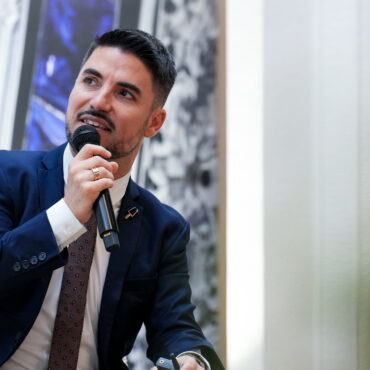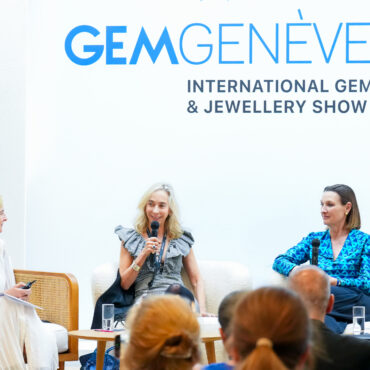At the heart of Cartier’s enduring appeal lies a legacy carefully preserved, curated, and celebrated through the Cartier Collection. More than a mere historical archive, the Collection is a living manifestation of over 175 years of craftsmanship, innovation, and timeless elegance. During an engaging conversation, held during GemGenève May 2025 edition, between jewellery historian Amanda Triossi and Caroline Kranz, Deputy Curator of the Cartier Collection, the audience was taken on a rare journey into the inner workings of one of the most remarkable heritage initiatives in the world of high jewellery.
The Cartier Collection was officially established in 1983, but its essence took hold a decade earlier, in the 1970s, when Cartier started reacquiring iconic pieces from its illustrious past. Today, the Collection includes over 3,700 works, spanning three centuries of design, creativity, and craftsmanship. It features jewellery, timepieces, and treasured objects dating from as early as 1850 to contemporary creations of the 21st century.
What sets the Cartier Collection apart is not just its size but its remarkable depth. Each piece represents a story: of cultural changes, of shifting aesthetics, of technological advancements. According to Kranz, Cartier never aimed to amass wealth through this endeavour; rather, the Collection was designed to tell the history of the Maison itself. Items are acquired not for their commercial worth but for their capacity to capture a significant moment in Cartier’s artistic or historical journey.
The process of authentication is a cornerstone of the Collection’s credibility. Unlike many heritage archives, Cartier is fortunate to retain original records in its historic locations in Paris, London, and New York. These archives include detailed design drawings, photographs, order books, and even plaster casts—allowing the curatorial team to trace a jewel’s origin with remarkable precision. Kranz recalled a particularly evocative example: a chatelaine from 1874, identified through an original sketch dated October 22 of that year, still preserved in the Paris ledger.
Equally revealing are the pieces that return to Cartier through serendipity. One such moment occurred during preparations for an exhibition in Geneva, where curators had selected an archival photograph of a Chinese-inspired brooch for the catalogue. To their astonishment, a private collector appeared shortly afterwards with the exact brooch—in pristine condition—offering it for sale. That encounter transformed the archival image into a tangible, re-acquired masterpiece.
The Collection also features many examples of Cartier’s famous transformable jewellery. A 1909 brooch pendant, originally from a dismantled necklace, was authenticated using a plaster cast and a period photograph showing the piece in its original form. Such examples provide insights not only into design but also into how jewellery was worn, repurposed, and valued across generations.
Collectors often become unexpected participants in Cartier’s evolving story. As Kranz observed, many approach not to sell but to share family heirlooms and stories. Through these generous exchanges, the Collection continues to expand in both scope and significance, revealing undocumented commissions and shining a light on overlooked chapters in the Maison’s history.
Tiaras form a particularly rich category, with thirty examples arranged chronologically to show the evolution of fashion and design. From a 1902 silver-and-gold piece reflecting 19th-century techniques, to a delicate 1905 platinum tiara in the French garland style, to striking Art Deco designs featuring onyx and natural pearls—each one embodies the aesthetic language of its era. Arranged in chronological order for exhibitions, these tiaras not only illustrate changing aesthetics but also mirror societal transformations, as women’s roles evolved and jewellery became a statement of identity as much as status. Some tiaras, like the impressive 1937 aquamarine and diamond piece, are transformable, with detachable elements that can be worn as brooches.
One of the most captivating stories in the Cartier Collection involves the legendary Maharaja of Patiala necklace. Long believed to be lost to history, a fragment appeared in the trade during the late 1990s. Over time, other components surfaced—sometimes unexpectedly—and Cartier’s restorers painstakingly reconstructed the ceremonial necklace. This detective-like pursuit, as Kranz explained, illustrates how the Collection is as much a project of recovery as it is of preservation.
Wristwatches and mystery clocks also play a central role in Cartier’s narrative of innovation. With nearly 1,000 wristwatches, the collection documents milestones such as the first Santos watch, created in 1904 for aviator Santos-Dumont. The evolution of the Tank, Tonneau, Tortue, and Crash watches illustrates Cartier’s contribution to modern watchmaking. Amanda Triossi expressed particular admiration for the Crash model—a symbol of bold, unconventional design born in Cartier London. Among them, the very first Crash watch from 1967 holds a place of honour in the collection.
Meanwhile, the Maison’s renowned mystery clocks—ingeniously designed to make it seem as if the hands float without mechanical support—stand as a testament to decades of collaboration between watchmakers and designers. Caroline Kranz mentioned that even Cartier’s own shop clerks in the early 20th century could not explain how these clocks operated, adding to the aura of mystery for their clients.
Geographical influence adds another layer. Pieces inspired by Russian enamelling, Islamic geometry, and Indian royalty showcase Cartier’s global reach. The famous commission for the Maharaja of Patiala is a prime example: a ceremonial platinum necklace set with engraved rubies and diamonds, later restored in Cartier’s workshops after being found in fragments. The Tutti Frutti style, mixing Eastern materials with Western aesthetics, is perhaps the most iconic blend of cultures—symbolised by a 1936 necklace once owned by socialite Daisy Fellowes, which achieved a record price at auction before being repurchased by Cartier.
The Collection also features numerous items that tell personal stories. A pair of striking rock crystal and diamond bracelets once owned by Gloria Swanson showcase the glamour of 1930s cinema and can be seen in many period photographs of the actress. Barbara Hutton’s jade bead necklace, customised by Cartier to match her changing tastes, underwent several modifications at Cartier’s workshops in New York and Paris, reflecting the Maison’s close and enduring relationships with its elite clients. The Duchess of Windsor’s flamboyant commissions, such as the famous panther brooch and her amethyst-and-turquoise necklace, highlight Cartier’s bespoke craftsmanship and the creative vision of Jeanne Toussaint, who was the driving force behind the panther design.
Beyond jewels, the Collection features vintage handbags, vanity cases, and objets d’art—many designed by pioneering women such as Jeanne Toussaint and Micheline Kanoui. Their creative leadership helped shape Cartier’s identity over decades, influencing everything from leather goods to high jewellery.
Preserving and showcasing these works is no small feat. The Cartier team, currently numbering around fifteen, includes curators, archivists, logisticians, and restorers. Their duties encompass documentation, exhibition preparation, and conservation. Every jewel is catalogued, photographed, and stored carefully under controlled conditions. Restoration is guided by a philosophy of respect: if a piece was altered by Cartier for a client, that transformation is preserved; but if changes were made externally, the team may restore the jewel to its original state.
The behind-the-scenes of Cartier exhibitions reveals an entirely different level of artistry: logistics. Planning often begins years in advance, involving collaboration with curators, designers, and conservation experts from museums worldwide. As Kranz described, the team sometimes builds life-sized mock-ups of showcases in their offices, even substituting placeholders like stacked A3 paper to simulate borrowed museum objects. This rigorous preparation ensures a seamless installation once on site.
Exhibitions are a vital part of the Collection’s mission. Since 1989, Cartier has organised forty-three monographic shows worldwide, collaborating with esteemed institutions like the British Museum, the Palace Museum in Beijing, and, most recently, the Victoria and Albert Museum in London. Each exhibition involves a complex process of planning, transportation, display, and scholarship—an endeavour that highlights Cartier’s heritage to the public. As Kranz observed, cultural institutions are increasingly recognising the artistic legitimacy of jewellery, and Cartier’s exhibitions often rank among the most visited at the host venues.
The Collection has even made quiet appearances on red carpets. In a rare initiative, Cartier loaned historical pieces for the Met Gala in New York, with celebrities such as Rihanna and Myles Harris wearing archival jewels. These moments of glamour subtly reinforce the Maison’s relevance, connecting the past with the present through style.
In the final moments of their conversation, Amanda Triossi asked Caroline Kranz if there were any jewels she personally wished would return to the Collection. With a smile, Kranz mentioned the missing bracelet from the disassembled Patiala tiara. Her response was as much about hope as it was about history—a reminder that the Cartier Collection remains a dynamic archive, still unfolding, still evolving.
Through this Collection, Cartier does more than simply preserve objects of beauty. It safeguards the threads of memory, identity, innovation, and artistry that have defined the Maison for nearly two centuries. It is not merely a collection of jewels, but a collection of stories—stories that continue to shine.
Speakers:
- Amanda Triossi (Jewellery historian)
- Caroline Kranz (Deputy Curator of the Cartier Collection)





